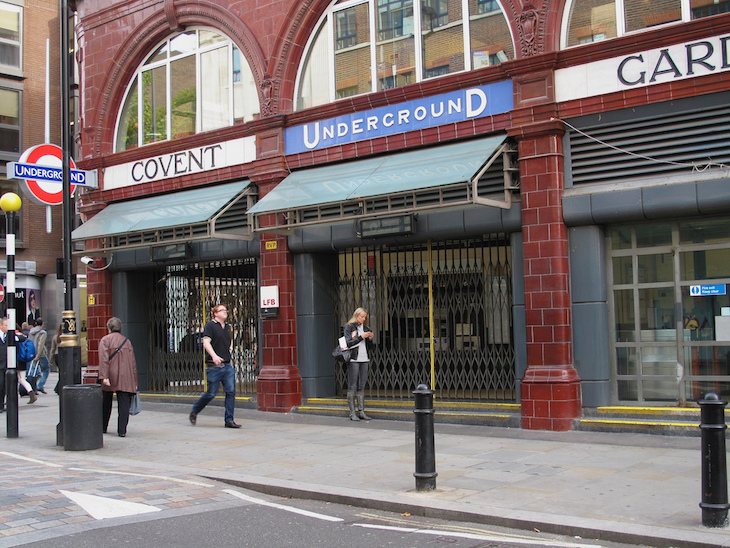
1. London's oldest restaurant
Rules on Maiden Lane lays claim to being London's oldest restaurant. It was opened in 1798 by Thomas Rule as an oyster bar. It left the Rule family early in the 20th century when Charles Rule swapped it for Alhambra, a restaurant in Paris. Today it serves traditional, gamey British food.
2. London's shortest tube ride
Tube travellers bound for Covent Garden are often informed that it's easier to get out at Leicester Square station and walk to Covent Garden than alighting at Covent Garden station. There's a reason for that — these two stations are closest together of all stations on the network, with a journey time of roughly 45 seconds between them. What's more, Covent Garden station has no escalators — only lifts and stairs — so by the time you've fought your way out, it probably would have been quicker to walk.
3. The six seven dials of Seven Dials
We've all done it. Stood in the centre of Seven Dials and counted to check there are definitely seven (there are, although it can be a time-consuming task if done after frequenting one of the area's many bars). There were very nearly only six roads (hence the pillar in the centre has six sundials) but plans were revised at the last minute.
The number is not really of any significance — it's the layout of the area that's important. The road layout was designed by Thomas Neale, a politician who was hoping to cash in on the success of other up-and-coming areas, in the 1690s. The area is laid out in a series of triangles to maximise the number of properties that could be fitted into the area — rent was charged according to the size of the frontage of the house, rather than the size of the interior.

4. Punch & Judy history
Puppet show Punch & Judy may seem like a British seaside tradition, but the first mention of the show in the UK was in Covent Garden.
Samuel Pepys mentioned seeing "an Italian puppet play, that is within the rails there, which is very pretty" in Covent Garden in May 1662. The area is still known for its street performances today, and the Punch & Judy pub sits in Covent Garden Piazza.
5. The Hitchcock connection
Film maker Alfred Hitchcock's father, William Hitchcock, was a greengrocer at Covent Garden market. Hitchcock's 1972 film, Frenzy, is about a serial killer who is also a fruit wholesaler at the market.
6. Peppercorn rent
The Covent Garden Area Trust pays a yearly rent of one red apple and a posy of flowers for each of the buildings and market halls (making a total rent of five apples and five posies). They are owned by CapCo and GE Real Estate, and the 'peppercorn rent' is so small as it only exists for the purpose of a contract being drawn up.
The Rent Ceremony is a public event, when the Chairman, trustees, Town Crier and a jazz band march around the square to pay the rent. Keep an eye on this webpage for details of the next ceremony.
7. Hidden ears
Just as Soho claims to have seven secreted 'noses', Covent Garden has its own set of hidden ears.
Two of them are mounted on walls on Floral Street, with several others rumoured to be dotted around London. Artist Tim Fishlock made casts of his own ears to create them.
(If you're interested in Soho's noses, tour guide Peter Berthoud regularly does guided walks to their locations.)

8. Beechams pharmaceuticals
For a time, the Covent Garden Estate was owned by Beechams, the family behind the pharmaceutical company. It was purchased by the family in 1918, and was managed for them by a property company who sold off several of the buildings. In 1962 the Beechams family sold off the remaining properties to the newly-established Covent Garden Authority.
9. The gaslit street
Much of Covent Garden is still lit by gas lamps, including Goodwins Court, which is often used to film period dramas.
The arcade arches, including those outside the Apple store, are also gaslit, and the worker who was to maintain them is often ridiculed by the street performers.
10. Where the name comes from
Many people guess —correctly — that Covent comes from the word 'convent'. In around 1200, the area now known as Covent Garden was walled of and used by Westminster Abbey as arable land, including orchards, and was known as "the garden of the Abbey and the Convent". By the time Henry VIII had seized the land in 1552, it was known as Covent Garden.
11. You can tour Freemasons Hall
Freemasons' Hall, on Great Queen Street, is the centre of English freemasonry. A freemasons' hall has stood on the site since 1775, although the current building is the third incarnation.
What many people don't realise is that free public tours of the Grand Temple and ceremonial areas are available. See the website for details.





